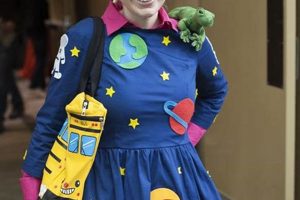Creating a homemade representation of the attire worn by the character Anakin Skywalker involves constructing a garment, often utilizing readily available materials and do-it-yourself techniques. This approach allows individuals to replicate iconic looks from the Star Wars saga without purchasing pre-made, commercially available outfits. For example, a fan might use dark-colored fabric, belts, and boots to assemble a costume resembling his appearance in “Revenge of the Sith.”
Constructing a costume offers several advantages, including cost savings and the opportunity for personalization. Individuals can tailor the design to their specific measurements and preferences, resulting in a more accurate and comfortable representation. Historically, fan-made costumes have been a staple of science fiction conventions and events, demonstrating a commitment to the source material and providing a platform for creative expression. The ability to individually craft a character’s look fosters a deeper connection with the narrative.
The following sections will explore essential components and techniques involved in crafting various iterations of the character’s attire, providing guidance on fabric selection, pattern adaptation, and prop creation. These detailed instructions aim to facilitate the construction of an impressive and recognizable representation of this iconic character.
Crafting an Effective Representation
Successfully assembling a recognizable depiction of Anakin Skywalker requires careful attention to detail and resourcefulness. The following guidelines offer practical advice for crafting various elements of the costume.
Tip 1: Fabric Selection: Opt for durable, medium-weight fabrics such as cotton twill or linen blends for the tunic and pants. These materials offer both comfort and a screen-accurate appearance. Avoid overly shiny or synthetic materials, which can detract from the authenticity.
Tip 2: Color Accuracy: Pay close attention to the specific shades of brown, black, and grey used in the character’s different outfits. Referencing official images and resources can help ensure accurate color matching when sourcing fabrics and accessories.
Tip 3: Pattern Adaptation: Start with basic clothing patterns and modify them to match the unique cuts and styles of Anakin’s attire. Simplicity patterns and online resources offer templates that can be adapted to create the desired silhouette.
Tip 4: Belt Construction: The belt is a crucial element. Consider using sturdy leather or pleather for the construction. Accurate buckle designs can be 3D printed or sourced from online retailers specializing in costume components.
Tip 5: Boot Selection: Choose knee-high boots in a dark brown or black color. Tactical boots or riding boots can be modified to achieve the desired look. Pay attention to the details of the boot’s texture and shape.
Tip 6: Lightsaber Hilt: While not part of the clothing, the lightsaber hilt significantly enhances the overall representation. Replica hilts are available for purchase, or individuals can attempt to construct their own using metal tubing, plastic parts, and accurate reference images.
Tip 7: Jedi Robe Accuracy: If incorporating a Jedi robe, ensure it is a heavy, flowing fabric in a shade of brown or tan. The hood and sleeves should be appropriately sized and shaped to accurately replicate the character’s silhouette.
Tip 8: Weathering and Detail: Subtle weathering can enhance the realism of the costume. Applying light distressing to the fabric and accessories can simulate wear and tear, creating a more authentic appearance. However, avoid overdoing it.
By carefully considering fabric selection, color accuracy, and construction techniques, individuals can create a compelling and recognizable representation of the iconic character. The key is to prioritize detail and strive for accuracy in all aspects of the design.
The following sections will delve into specific elements of various iterations of the attire, providing further detailed instructions and guidance for achieving an impressive result.
1. Fabric Selection and Accuracy
Fabric selection constitutes a foundational element in successfully executing a homemade representation of the character’s attire. The accuracy of fabric choices directly impacts the visual fidelity of the costume and its ability to convincingly replicate the on-screen appearance. Inaccurate fabric selection, for instance, employing a modern, brightly colored polyester, would immediately detract from the intended rugged, utilitarian aesthetic. The correct selection of materials, conversely, significantly enhances the overall impression.
The cause-and-effect relationship is evident: selecting appropriate fabrics, such as linen blends or cotton twill, leads to a costume that more closely resembles the textures and draping qualities depicted in the source material. This necessitates a careful consideration of weight, weave, and color. For example, the tunic often features a specific shade of brown that should be matched as closely as possible through fabric sourcing. Furthermore, the drape of the fabric affects how the garment falls and moves, contributing to the overall silhouette. Using a fabric that is too stiff or too flimsy will impact the final appearance negatively.
Understanding the significance of fabric selection and accuracy serves as a crucial first step in the creation process. It allows for informed decisions that contribute to a higher-quality final product. Overlooking this stage often results in a costume that appears cheap or inaccurate, diminishing the overall impact. By prioritizing correct fabric choices, individuals can elevate their work from a simple imitation to a more authentic representation, celebrating the character effectively through meticulously crafted attire.
2. Pattern Modification Techniques
Adapting existing sewing patterns to accurately replicate the characters attire is paramount in successful homemade costume construction. Commercial patterns rarely match the specific cuts and detailing required, necessitating modifications to achieve an authentic appearance.
- Sleeve Adjustments
The characters tunics often feature unique sleeve designs, sometimes with wider openings or distinct shaping. Modifying standard sleeve patterns involves altering the width, length, and cuff shape to match the source material. Failure to accurately modify sleeves results in a visually dissimilar silhouette, diminishing the overall impression.
- Torso Shaping
Achieving the correct fit through the torso requires careful adjustments to pattern pieces. This may involve adding or removing fabric at the side seams, adjusting the shoulder slope, and alter
ing the neckline. An ill-fitting torso detracts from the costume’s realism and can impact comfort. Precise alterations are crucial for mimicking the character’s physique. - Pant Leg Alterations
The trousers frequently display specific cuts, such as straight legs or slight flares. Modifying standard pant patterns involves adjusting the leg width, inseam length, and hem style. Inaccurate pant leg alterations will misrepresent the lower body silhouette and reduce the costume’s accuracy. Consideration of boot coverage is also essential.
- Collar and Neckline Adjustments
Tunics and robes may incorporate distinctive collar and neckline designs. Modifying these elements requires careful pattern manipulation to achieve the correct shape, height, and closure style. An improperly modified collar or neckline can significantly alter the visual impact of the upper garment, impacting the character’s recognizable features.
These pattern modification techniques are indispensable for individuals aiming to create convincing attire. Mastery of these alterations allows for precise replication of unique design elements, leading to a more accurate and visually compelling final product. Neglecting these adjustments reduces the authenticity, demonstrating the vital role of pattern manipulation in this construction endeavor.
3. Belt and Accessory Fabrication
The construction of accurate belts and accessories is critical for achieving a convincing representation. These components contribute significantly to the overall realism and visual impact, often serving as defining elements of the character’s various appearances. Proper fabrication elevates the overall quality and accuracy of a do-it-yourself recreation.
- Belt Construction Materials
Material selection for the belt directly impacts its durability and visual authenticity. Leather, pleather, or heavy-duty nylon webbing are commonly employed. Leather offers a classic, rugged appearance, while pleather provides a more cost-effective and readily available alternative. Nylon webbing offers superior strength and can be dyed or painted to achieve the desired color. The choice depends on the desired level of accuracy and the available budget.
- Buckle Replication Techniques
The belt buckle is a focal point, often featuring unique designs specific to each iteration of the character. Methods for replicating these buckles range from 3D printing to scratch-building using metal or plastic. 3D printing allows for highly accurate reproductions but requires access to a printer and design software. Scratch-building involves crafting the buckle from raw materials, demanding greater skill and precision. Commercially available replica buckles offer a simpler alternative, albeit at a potentially higher cost.
- Pouch and Attachment Creation
Many variations of the attire incorporate pouches, holsters, or other utility attachments on the belt. Constructing these elements requires careful consideration of size, shape, and attachment methods. Leatherworking techniques, sewing, or the use of adhesives are common approaches. Attention to detail, such as accurate stitching and hardware selection, enhances the overall authenticity.
- Accessory Detailing and Weathering
The application of realistic detailing and weathering enhances the believability of the fabricated belts and accessories. This can involve techniques such as dry brushing, staining, or the application of textured paints to simulate wear and tear. Accurate weathering contributes to a more authentic and visually compelling final product.
The meticulous fabrication of belts and accessories is indispensable for creating a high-quality representation of this iconic character. These elements, often overlooked, contribute significantly to the overall visual impact and realism. Skilled craftsmanship in this area elevates a costume from a mere imitation to a detailed and respectful homage.
4. Boot and Footwear Details
The selection and accurate representation of boots and footwear form an essential component of a successful attire recreation. Footwear serves as a grounding element, contributing significantly to the overall silhouette and visual consistency. The specific style, color, and details of the footwear must align with the character’s attire, or the entire effort risks appearing inaccurate. The effect of incorrect footwear diminishes the impact of even meticulously crafted garments and accessories. For instance, sporting modern sneakers instead of knee-high leather boots clashes dramatically with the aesthetic and renders the entire creation unconvincing.
Consider the character’s attire in “Revenge of the Sith.” The tall, dark brown or black leather boots are integral to the overall impression. Achieving the correct look may involve modifying existing footwear, such as riding boots or tactical boots, to match the specific height, shape, and texture depicted in reference images. This modification could entail adding straps, altering the heel, or applying weathering techniques to simulate wear and tear. Disregarding these details results in a significant visual discrepancy, undermining the attention to detail evident in other aspects of the constructed garment. An accurate footwear choice reinforces the impression of authenticity, significantly improving the overall presentation.
In summary, the accurate portrayal of boots and footwear is a crucial element in constructing a convincing representation. Attention to these seemingly minor details elevates the quality of the finished product, ensuring a cohesive and authentic recreation. While challenges such as sourcing appropriate materials or executing complex modifications may arise, prioritizing footwear accuracy contributes significantly to the overall success of the project. This emphasis aligns with the broader goal of meticulously replicating iconic features for a compelling homage to the character.
5. Lightsaber Hilt Construction
The creation of a lightsaber hilt is an integral component of crafting a complete and convincing representation. While the attire provides the visual foundation, the lightsaber hilt serves as a crucial accessory, immediately identifying the character and enhancing the overall authenticity of the recreation.
- Material Selection
The choice of materials significantly impacts the durability, weight, and aesthetic of the hilt. Metals such as aluminum or steel provide a robust and realistic feel, while plastics offer a more lightweight and cost-effective alternative. Aluminum, often favored for its machinability, allows for intricate detailing and a metallic sheen that closely resembles the hilts depicted in the films. The selection of materials must balance visual accuracy with considerations of budget and fabrication skill.
- Accuracy of Design
Replicating the exact dimensions and design elements of a specific lightsaber hilt is paramount for achieving a screen-accurate prop. Ref
erence images and schematics are essential resources for ensuring that the hilt’s proportions, grips, and activation switch placement match the source material. Subtle variations in design can significantly impact the recognizability and overall impression. Accessing detailed references is crucial for achieving high levels of accuracy. - Fabrication Techniques
Constructing a lightsaber hilt involves a variety of fabrication techniques, ranging from machining and 3D printing to simple assembly of pre-made parts. Machining allows for the creation of intricate metal components with precise dimensions, while 3D printing enables the replication of complex shapes and textures. Combining these techniques or utilizing simpler methods, such as assembling plastic parts, offers flexibility in achieving the desired result.
- Finishing and Detailing
The finishing touches, including painting, weathering, and the addition of small details, significantly enhance the realism of the lightsaber hilt. Applying metallic paints, weathering effects, and adding small screws, buttons, or wires can create a convincing impression of a functional weapon. Careful attention to these details elevates the hilt from a simple prop to a recognizable and impressive accessory.
The meticulous construction of a lightsaber hilt complements the attire, transforming a basic costume into a comprehensive recreation. The hilt serves as a symbol of the character’s identity, significantly enhancing the visual impact and overall authenticity of the recreation. The creation of a lightsaber hilt demonstrates a commitment to detail and adds a significant layer of depth to the overall result.
Frequently Asked Questions
This section addresses common inquiries and misconceptions regarding the construction of a representation of the character Anakin Skywalker’s attire.
Question 1: What are the essential components for constructing a screen-accurate rendition?
A faithful recreation necessitates a tunic, trousers, belt, boots, and, optionally, a Jedi robe. Attention should be given to fabric selection, color matching, and accurate accessory replication to ensure visual fidelity.
Question 2: Where can accurate reference materials for detail replication be found?
Official film stills, behind-the-scenes photographs, and prop replicas serve as valuable resources. Online databases and forums dedicated to costume construction also offer detailed reference materials and community expertise.
Question 3: What are the primary challenges in replicating the belt and accessories?
Securing accurate buckles and pouches proves challenging. 3D printing, scratch-building, or sourcing commercially available replica parts offer potential solutions. Attention to accurate dimensions and finishing is critical.
Question 4: What fabrics are best suited for replicating the tunic and trousers?
Medium-weight cotton twill, linen blends, or fabrics with similar texture and drape are recommended. Accurate color matching is crucial; darker browns and blacks are generally employed.
Question 5: How can existing clothing patterns be modified to match the unique designs?
Pattern alteration techniques, including sleeve adjustments, torso shaping, and collar modifications, are required. Understanding basic sewing principles and having access to reference images facilitates accurate pattern manipulation.
Question 6: Is prior sewing experience necessary to successfully complete a homemade rendition?
While prior sewing experience is beneficial, it is not strictly required. Beginner-friendly resources and tutorials are available. Starting with simpler components and gradually progressing to more complex elements is advisable.
The construction of a faithful representation requires dedication to detail and resourcefulness. Careful planning and meticulous execution contribute significantly to the overall success of the project.
The following section will provide tips and tricks to solve common problems.
Conclusion
This exploration has outlined the process of undertaking a homemade replica of the character’s iconic garments. Key aspects, including fabric selection, pattern modification, accessory fabrication, and meticulous attention to detail, have been emphasized as fundamental components. Through careful planning and precise execution, a recognizable and impressive attire can be achieved.
The pursuit of such a creation presents a unique opportunity for creative expression and demonstrates a commitment to the source material. While challenges may arise, the principles outlined provide a framework for navigating the complexities involved. The resulting garment serves not only as a physical representation but also as a testament to dedication and craftsmanship.







